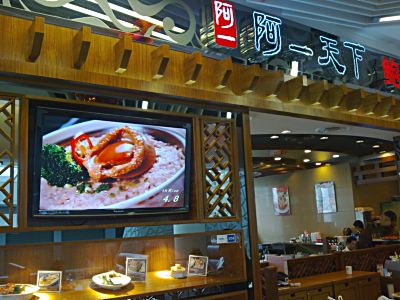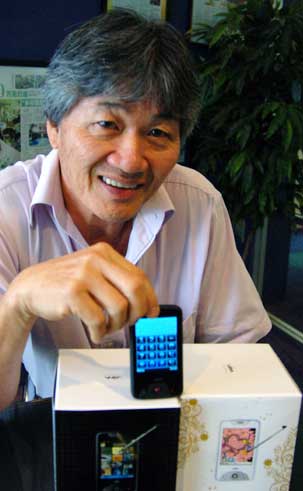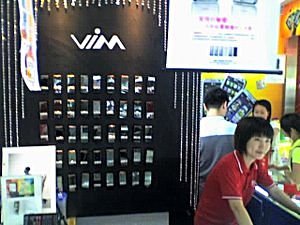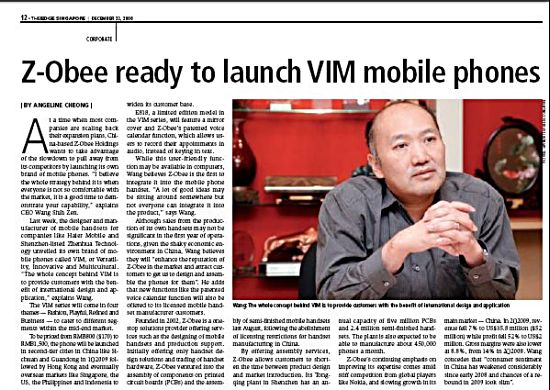
In the limelight on The Edge: Wang Shih Zen, chairman and CEO of Z-Obee.
The Edge this week reported that Z-Obee (listed on SGX on 21 Nov 2007 at an IPO price of S$0.34) unveiled its own brand of mobile phones called VIM, or Versatility, Innovative and Multicultural.
“The whole concept behind VIM is to provide customers with the benefit of international design and application,” explained Wang Shih Zen, chairman and CEO of Z-Obee, the designer and manufacturer of mobile handsets for companies like Haier Mobile and Shenzhen-listed Zhenhua Technology.
To be priced from RMB800 ($170) to RMB1,500, the phone will be launched in second-tier cities in China like Sichuan and Guandong in 1Q2009 followed by Hong Kong. Eventually, it will hit overseas markets like Singapore, the US, the Philippines and Indonesia.
E818, a limited edition model in the VIM series, will feature a mirror cover and Z-Obee’s patented voice calendar function, which allows users to record their appointments in audio, instead of keying in text.
Wang told The Edge that Z-Obee is the first to integrate it into the mobile phone handset. “A lot of good ideas may be sitting around but not everyone can integrate it into the product,” said Wang.
He added that new functions like the patented voice calendar function will also be offered to its licensed mobile handset manufacturer customers.
*****
IN AN article datelined Beijing, XFN-ASIA reported on Dec 19 that Z-Obee Holdings sees its superior technology and leading-edge design capabilities as key to its long-term growth in China, the world's largest mobile phone market.
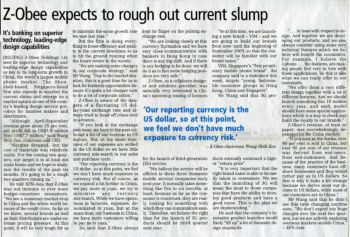
XFN-Asia article was reproduced in BT.
The article was subsequently republished in the Singapore Business Times.
Z-Obee, which is based in Shenzhen, said it expected to weather the current slump and emerge on a market upturn as one of the country's leading design service providers for handset makers and distributors.
"Although April-September revenue grew about 25 pct, net profit fell to 3.9 mln usd from 7.7 mln. Margins dropped, but the cost of materials was relatively stable. For the coming two quarters, our target is to atleast not make losses and we hope to maintain the results of the past six months. It's going to be a tough two quarters coming up," said Wang Shih Zen, chairman and CEO, in an interview with XFN-Asia.
Other key points:
Consumer sentiment: "We see a consumer market drop in China and the whole world because of the credit crisis. As far as we know, several brands as well as their distributors are under extreme pricing pressure. At this point, it will be very tough for us to maintain the same growth rate we saw lastyear."
3G in China: Z-Obee, as a cell phone designer and solutions provider, was naturallyvery interested in China's upcoming issuing of licences for the launch of third generation (3G) service.
"We believe the service will be offered to these three (domestic mobile service) companies early next year. It normally takes something like five to six months, at least because as far as the consumer is concerned,they are really looking for something with which they can communicate easily. Therefore, we believe the right time for the launch of 3G products should be third quarter next year.
"So at this time, we are launching a new brand -- VIM -- and we are going to build our brands from now until the beginning of September 2009, so that the consumer will be familiar with our brand name."
Innovative products: "We should launch something like 10 models every year, and each model should have some special applications which is a way to check and build the loyalty to our brands."
Key revenue source: Z-Obee's revenue, at least on paper, was overwhelmingly dependent on the China market. "If you look at the books, over 90 pct is sold in China, but over 95 pct of our revenue was derived from end-users, from end customers. And because of the practice of the business, many customers have offshore businesses and they would rather pay us in US dollars. So that is why it looks a bit strange because we derive most our income in US dollars, while most of our customers are in China."
Wang said he didn't see this ratio changing anytime soon. "We don't expect any huge changes over the next two quarters, but we are actively exploring overseas markets outside China.
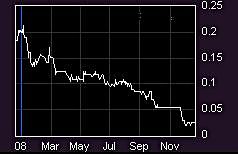
Z-Obee stock has lost 86% of its value from a year ago.
Shift from OEM to ODM: Mr Wang said over the company's six-year history, it has shifted from mainly OEM to ODM. "And now we have our own brand name. In fact, the change is not sudden. It's part of a bigger plan. It has been in the management's mind for years."
He said that in the past, China had licensing requirements for handset manufacturers.
"If you had 200,000 yuan to 200 mln yuan working capital, core manufacturing, an R&D center, repair and maintenance center ... then you got licensing. But from end-2007, these rules were abolished and now there are licensing requirements for Chinese companies."
He said this made for a market rife with consolidation and technical upgrade opportunities. "We think now is a good time for us to move from a solutions provider to more of an established brand-name manufacturer, and to also provide solutions to our distributors as well as our licensed manufacturers."
Climbing up the value chain: The company's future success in China was underpinned by its ability to move up the value chain.
"A lot of Chinese manufacturers win most foreign orders due to cost advantages as opposed to so-called innovative practices. Most of the products you see from other manufacturers in China, they are either highly economical or tailored more for the Chinese market, which we don't see as having too much global potential."
Recent story: Z-OBEE: Trading 65% below Net Asset Value




